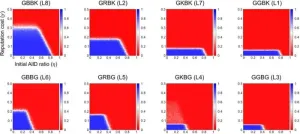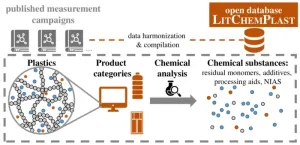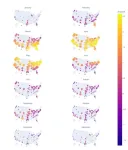(Press-News.org) Prostate cancer is the second most common cancer in men, and almost 300,000 individuals are diagnosed with it each year in the U.S. To develop a consistent method of estimating prostate cancer size, which can help clinicians more accurately make informed treatment decisions, Mass General Brigham researchers trained and validated an AI model based on MRI scans from more than 700 prostate cancer patients. The model was able to identify and demarcate the edges of 85% of the most radiologically aggressive prostate lesions. Tumors with a larger volume, as estimated by the AI model, were associated with a higher risk of treatment failure and metastasis, independent of other factors that are normally used to estimate this risk. Furthermore, for patients who received radiation therapy, the tumor volume performed better than traditional risk stratification for predicting metastasis. Researchers believe the tool could be used to help clinicians understand a tumor’s aggressiveness, to inform more personalized treatment plans, and to guide radiation therapy. The study is published in the journal Radiology.
“Al-determined tumor volume has the potential to advance precision medicine for patients with prostate cancer by improving our ability to understand the aggressiveness of a patient's cancer and therefore recommend the most optimal treatment,” said first author David D. Yang, MD, of the Department of Radiation Oncology at Brigham and Women’s Hospital, a founding member of the Mass General Brigham healthcare system.
MRI has improved the ability for clinicians to diagnose prostate cancer and is a routine part of diagnosis and treatment. While human clinicians can estimate tumor size based on MRI images, these estimates are somewhat subjective and can vary from person-to-person.
To develop a more consistent method of estimating tumor size, the researchers trained an AI model based on MRI images of prostate cancer tumors from 732 patients undergoing treatment at a single center. They then investigated whether the AI model’s size estimates were associated with treatment success in the 5-to-10 years following diagnosis.
They showed that the AI model was able to locate and measure around 85% of prostate tumors that had a PI-RADS (Prostate Imaging Reporting and Data System) 5 score within the patient cohort. The score indicates a very high risk of clinically significant prostate cancer. The model’s size estimates also showed potential as a prognostic marker: larger tumors were associated with higher risk that prostate cancer would come back, as measured by blood levels of prostate-specific antigen (PSA), or metastasize, both for patients who were treated surgically or with radiation therapy.
“The AI measurement itself can tell us something additional in terms of patient outcomes,” said senior author Martin King, MD, PhD, of the Department of Radiation Oncology at the Brigham. “For patients, this can really tell them something about what are the chances of cure, and the likelihood that their cancer will reoccur or metastasize in the future.”
In addition to helping clinicians and patients understand their cancer’s aggressiveness, the AI model could also help guide radiation oncologists by pinpointing the tumor’s focal region for more targeted treatment. It’s also a much faster test compared to currently used methods of predicting prostate cancer aggressiveness, which usually take two weeks or longer to yield results. AI-informed testing could mean that patients can begin treatment sooner.
Cancer research is a foundational pillar in the care Mass General Brigham provides to patients. Research, along with the power of the system’s strengths in innovation, education and community engagement, allows Mass General Brigham Cancer to deliver integrated cancer care for all, putting health equity at the center of that support. The vision is to provide a comprehensive, integrated and research-informed approach to cancer care, helping patients navigate their entire journey of care, from prevention and early detection to treatment and survivorship.
Looking ahead, the researchers are planning to test their model with a larger, multi-institutional dataset.
“We want to validate our findings, using other institutions and patient cohorts with different disease characteristics, to make sure that this approach is generalizable to all patients,” said Yang.
Authorship: In addition to Yang and King, Mass General Brigham authors include Leslie K Lee, Jonathan E Leeman, Atchar Sudhyadhom, Christian V Guthier, Quoc-Dien Trinh, Kent W Mouw, Neil E Martin, Peter F Orio, Paul L Nguyen, Anthony V D’Amico, Kee-Young Shin, and Katie N Lee. Additional authors include James MG Tsui. Heather M McClure, and Mary-Ellen Taplin.
Paper cited: Yang, D and Lee, L et al. “Artificial Intelligence-Derived Tumor Volume from Multiparametric MRI and Outcomes in Localized Prostate Cancer” Radiology.
###
About Mass General Brigham
Mass General Brigham is an integrated academic health care system, uniting great minds to solve the hardest problems in medicine for our communities and the world. Mass General Brigham connects a full continuum of care across a system of academic medical centers, community and specialty hospitals, a health insurance plan, physician networks, community health centers, home care, and long-term care services. Mass General Brigham is a nonprofit organization committed to patient care, research, teaching, and service to the community. In addition, Mass General Brigham is one of the nation’s leading biomedical research organizations with several Harvard Medical School teaching hospitals. For more information, please visit massgeneralbrigham.org.
END
Using AI to measure prostate cancer lesions could aid diagnosis and treatment
Mass General Brigham researchers developed an AI model that can identify and measure aggressive prostate cancer lesions. The model’s estimates of tumor size were associated with the likelihood that the cancer would recur or spread
2024-10-29
ELSE PRESS RELEASES FROM THIS DATE:
Study uncovers alarming patterns in the effects of family violence
2024-10-29
A new synthesis of global evidence highlights a strong connection between family violence and long-term health consequences, significantly impacting the psychological and physical well-being of millions worldwide. This comprehensive review, the first of its kind, synthesises the findings from the most rigorous studies on child maltreatment and intimate partner violence, uncovering alarming patterns in the long-term effects of family violence.
According to the study, led by Matthias Burghart of the Max Planck Institute for the Study of Crime, Security, and Law, and Sophia ...
Emerging technology for extended preservation of organs for transplant requires new ethical & legal guidelines
2024-10-29
Leading ethics experts and researchers have co-authored a breakthrough paper calling for new governance and legal rules to guide application of emerging technology to preserve organs for transplant.
Current law and guidance are inadequate for emerging biopreservation technologies that will allow long-term storage of human organs for transplantation. The technology is much needed to address the severe time constraints that currently limit the viability of donor organs. Those constraints have contributed to a severe organ shortage, which affects patients throughout ...
Transcriptomics-based study on the mechanism of heart failure amelioration by water decoction and water-soluble alkaloids of Fuzi
2024-10-29
Background and objectives
Fuzi, the processed product of daughter roots of Aconitum carmichaelii Debx., is a well-known Chinese medicine for the treatment of heart failure (HF) and related cardiac diseases. This study aimed to investigate the molecular mechanism of the cardioprotective effects of Fuzi water decoction (FWD) and Fuzi water-soluble alkaloids (FWA) on the model of HF.
Methods
The HF model of rats was prepared through intravenous injection of propafenone hydrochloride. The normal group, model group, FWD-treated groups (1.25 g/kg, 2.5 g/kg, 5 g/kg) and positive group (Shenfu Injection, 3.3 mL/kg) were set up. Heart rate, LV+dp/dtmax, and ...
A novel probe technology for detecting native albumin activity as a biomarker in patients with hepatitis B-related cirrhosis and hepatocellular carcinoma and its clinical applications
2024-10-29
Background and objectives
Albumin is a major prognostic factor for patients with advanced liver disease, dependent on its concentration and biological activity. This study aimed to improve the method of active albumin detection and elucidate its predictive validity of albumin activity across hepatic disease progression and etiology.
Methods
This study synthesized a novel ratiometric fluorescent probe with an improved structure of 2′-FBPBN. The technique was used to detect native human albumin (HA) activity in 244 patients with hepatitis B cirrhosis (LC) and 66 patients with hepatocellular carcinoma (HCC). Clinical and laboratory data were also collected.
Results
Patients ...
A simulation study identifies robust social norms that sustain cooperation in costly reputations
2024-10-29
A groundbreaking study led by Prof. Dr. Hitoshi Yamamoto (Rissho University) and his collaborators from, Soka University, Koriyama Women’s College, and the RINRI Institute has made significant strides in the field of indirect reciprocity: a key mechanism for sustaining cooperation in human societies. Their research unveils new insights into the social norms that protect cooperative behaviour from defector invasion and reputation costs, thereby deepening our understanding of how large-scale societies maintain stability. The results of the study were published in Scientific Reports.
Indirect reciprocity is characterised by cooperative ...
Newly discovered cyanobacteria could help sequester carbon from oceans and factories
2024-10-29
An international coalition of researchers from the United States and Italy has discovered a novel strain of cyanobacteria, or algae, isolated from volcanic ocean vents that is especially adept at growing rapidly in the presence of CO2 and readily sinks in water, making it a prime candidate for biologically-based carbon sequestration projects and bioproduction of valuable commodities. This strain, nicknamed “Chonkus,” was found off the coast of the island of Vulcano in Sicily, Italy — an environment in which marine CO2 is abundant due to shallow volcanic vents. The discovery is described in a paper published ...
Making scents of aromas that differentiate beer and wine
2024-10-29
Today, people increasingly seek non-alcoholic versions of beer or wine. Despite boasting different flavors, these two drinks share many aromas, which makes it difficult to produce alcohol-free versions that mimic the real thing. Researchers in ACS’ Journal of Agricultural and Food Chemistry report on a literature analysis and experiment to characterize the chemical compounds that give beer and wine their unique fragrances. They say their findings could aid the development of flavorful, non-alcoholic substitutes.
Food and beverage researchers are working to recreate the enjoyable aromas and flavors of beer and wine in alcohol-free substitutes. However, because both beer and ...
FAU awarded DOE grant to test ocean current energy offshore Palm Beach County
2024-10-29
Imagine harnessing the power of ocean currents to generate clean, renewable energy right off the coast of Southeast Florida. Florida Atlantic University’s Southeast National Marine Renewable Energy Center (SNMREC) has been awarded an $800,000 grant from the United States Department of Energy’s Water Power Technologies Office to enable the commercial readiness of ocean energy technologies.
SNMREC, in collaboration with a team of experts including The City of Lake Worth Beach Electric Utility, 3U Technologies, 48 North Solutions, IDOM Incorporated, Braid Theory, and the European Marine Energy Centre (EMEC), ...
Open-access database compiles 3,500 substances measured in plastic products: Study highlights substantial knowledge gaps
2024-10-29
About this study: Plastics contain a vast number of chemicals, some of which greatly impact the environment and human health. However, information on the presence of individual substances in plastic products is oftentimes not publicly available. In a peer-reviewed study, set to be published on 29 October 2024, in Environmental Science and Technology Letters, a new publicly accessible database on chemicals measured in plastics is presented - LitChemPlast. The database contains over 3’500 substances measured in over 47'000 samples of plastic products across 372 studies.
Key findings:
• Contamination of recycled plastics:
The database shows that, due to ...
Internet activity reveals national allergy patterns
2024-10-29
Complaining about your allergies online might provide valuable data to researchers. Over 25% of Americans experience seasonal allergies, but how the prevalence of seasonal allergies varies across space and time remains obscure, in part because allergies seldom warrant visits to healthcare providers. Elias Stallard-Olivera and Noah Fierer mined Twitter (now X) posts and Google searches from 2016–2020 to extrapolate spatial and temporal allergy patterns. A natural language processing model sorted posts that indicated symptoms (e.g., “My allergies are really bad today!!”) from posts that include key words but did not indicate the presence of symptoms (e.g., “Gluten ...
LAST 30 PRESS RELEASES:
UVA’s Jundong Li wins ICDM’S 2025 Tao Li Award for data mining, machine learning
UVA’s low-power, high-performance computer power player Mircea Stan earns National Academy of Inventors fellowship
Not playing by the rules: USU researcher explores filamentous algae dynamics in rivers
Do our body clocks influence our risk of dementia?
Anthropologists offer new evidence of bipedalism in long-debated fossil discovery
Safer receipt paper from wood
Dosage-sensitive genes suggest no whole-genome duplications in ancestral angiosperm
First ancient human herpesvirus genomes document their deep history with humans
Why Some Bacteria Survive Antibiotics and How to Stop Them - New study reveals that bacteria can survive antibiotic treatment through two fundamentally different “shutdown modes”
UCLA study links scar healing to dangerous placenta condition
CHANGE-seq-BE finds off-target changes in the genome from base editors
The Journal of Nuclear Medicine Ahead-of-Print Tip Sheet: January 2, 2026
Delayed or absent first dose of measles, mumps, and rubella vaccination
Trends in US preterm birth rates by household income and race and ethnicity
Study identifies potential biomarker linked to progression and brain inflammation in multiple sclerosis
Many mothers in Norway do not show up for postnatal check-ups
Researchers want to find out why quick clay is so unstable
Superradiant spins show teamwork at the quantum scale
Cleveland Clinic Research links tumor bacteria to immunotherapy resistance in head and neck cancer
First Editorial of 2026: Resisting AI slop
Joint ground- and space-based observations reveal Saturn-mass rogue planet
Inheritable genetic variant offers protection against blood cancer risk and progression
Pigs settled Pacific islands alongside early human voyagers
A Coral reef’s daily pulse reshapes microbes in surrounding waters
EAST Tokamak experiments exceed plasma density limit, offering new approach to fusion ignition
Groundbreaking discovery reveals Africa’s oldest cremation pyre and complex ritual practices
First breathing ‘lung-on-chip’ developed using genetically identical cells
How people moved pigs across the Pacific
Interaction of climate change and human activity and its impact on plant diversity in Qinghai-Tibet plateau
From addressing uncertainty to national strategy: an interpretation of Professor Lim Siong Guan’s views
[Press-News.org] Using AI to measure prostate cancer lesions could aid diagnosis and treatmentMass General Brigham researchers developed an AI model that can identify and measure aggressive prostate cancer lesions. The model’s estimates of tumor size were associated with the likelihood that the cancer would recur or spread




